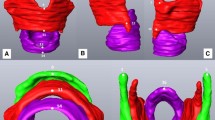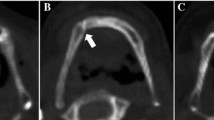Abstract
The aim of this study was to obtain a quantitative anatomical description of the hyoid bone using modern 3D reconstruction tools and to discuss potential applications of the knowledge in clinical practice. The study was conducted on 88 intact hyoid bones taken from cadavers during forensic autopsies (group 1) and on 92 bones from CT scan images of living adult subjects (group 2). Three-dimensional reconstructions were created from CT scan images using Amira 5.3.3® software. An anatomical and anthropological study of hyoid bones was carried out using metric and morphological analyses. Groups 1 and 2 were compared to evaluate the influence of muscle traction on hyoid bone shape. Characteristics of the hyoid bone were highly heterogeneous and were closely linked with the sex, height, and weight of the individuals. Length and width were significantly greater in men than in women (39.08 vs. 32.50 mm, p = 0.033 and 42.29 vs. 38.61 mm, p = 0.003), whereas the angle between the greater horns was larger in females (44.09 vs. 38.78, p = 0.007). There was a significant positive correlation between the height (Pearson coefficient correlation r = 0.533, p = 0.01) and weight (r = 0.497, p = 0.01) of subjects and the length of the hyoid bone. Significant metric differences were shown between group 1 and group 2. This very reproducible methodology is important because it may lead to clinical studies in, e.g., head and neck cancer or sleep apnea. Such studies are ongoing in our research program.







Similar content being viewed by others
References
Nakano T, Muto H, Yoshioka I. Anatomical studies in the hyoid region of the mouse in term of evolutional importance. Anat Anz. 1988;167:105–12.
Hilloowala RA. Comparative anatomical study of the hyoid apparatus in selected primates. Am J Anat. 1975;142:367–84.
Diego R, Pastor F, De Paz F, Potau JM, Bello-Hellegouarch G, Ferrero EM, Fisher RE. The head and neck muscles of the serval and tiger: homologies, evolution, and proposal of mammalian and veterinary muscle ontology. Anat Rec. 2012;295:2157–78.
Koebke J, Saternus KS. Morphology of the adult human hyoid bone. Z Rechtsmed. 1979;84:7–18.
Papadopoulos N, Lykaki-Anastopoulou G, Alvanidou E. The shape and size of the human hyoid bone and a proposal for an alternative classification. J Anat. 1989;163:249–60.
Miller KW, Walker PL, O’Halloran RL. Age and sex-related variation in hyoid bone morphology. J Forensic Sci. 1998;43:1138–43.
Pollard J, Piercecchi-Marti MD, Thollon L et al. Mechanisms of hyoid bone fracture after modelling: evaluation of anthropological criteria defining two relevant models. Forensic Sci Int. 2011;212(1–3):274. e1–5.
Mitterocker P, Gunz P. Advances in geometric morphometrics. Evol Biol. 2009;36:235–47.
Zelditch ML, Swiderski DL, Sheets HD. Geometric morphometrics for biologists: a primer. 2nd ed. Waltham: Academic Press; 2012. p. 488.
Badawi-Fayad J, Cabanis EA. Three-dimensional Procrustes analysis of modern human craniofacial form. Anat Rec (Hoboken). 2007;290:268–76.
Collard M, O’Higgins P. Ontogeny and homoplasy in the papionin monkey face. Evol Dev. 2000;3:322–31.
Hennessy RJ, Stringer CB. Geometric morphometric study of the regional variation of modern human craniofacial form. Am J Phys Anthropol. 2002;117:37–48.
Ponce de Leon M, Zollikofer C. Neanderthal cranial ontogeny and its implications for late hominid diversity. Nature. 2001;412:534–8.
Bookstein FL. Introduction to methods for landmark data. In: Rohlf FJ, Bookstein FL, editors. Proceedings of the Michigan morphometrics workshop. Ann Arbor: University of Michigan Museum of Zoology; 2000. p. 216–25.
Rohlf JF, Marcus LF. A revolution in morphometrics. Trends Ecol Evol. 1993;8:129–32.
O’Higgins P. The study of morphological variation in the hominid fossil record: biology, landmarks and geometry. J Anat. 2000;197:103–20.
Klingenberg CP. MorphoJ: an integrated software package for geometric morphometrics. Mol Ecol Resour. 2011;11:353–7.
Gower JC. Generalized procrustes analysis. Psychometrika. 1975;40(1):33–51.
Dryden I, Mardia KV. Statistical shape analysis. Chichester: Wiley; 1998.
Pollanen MS, Ubelaker DH. Forensic significance of the polymorphism of the hyoid bone shape. J Forensic Sci. 1997;42:890–2.
Leksan I, Marcikic M, Nikolic V, Radic R, Selthofer R. Morphological classification and sexual dimorphism of hyoid bone: new approach. Coll Antropol. 2005;29(1):237–42.
Mukhopadhyay PP. Morphometric features and sexual dimorphism of adult hyoid bone: a population specific study with forensic implications. J Forensic Leg Med. 2010;17:321–4.
Komenda S, Cerny M. Sex determination from the hyoid bone by means of discriminant analysis. Acta Univ Palacki Olomuc Fac Med. 1990;125:37–51.
Reesink EM, Van Immerseel AAH, Brand R, Bruintjes TJD. Sexual dimorphism of the hyoid bone? Int J Osteoarchaeol. 1999;9:357–60.
Greil H. Patterns of sexual dimorphism from birth to senescence. Coll Antropol. 2006;30:637–41.
Rouvière H. Os hyoide. In: Delmas A (ed), Anatomie humaine. Tête et cou, vol. 1, 11th edn. Paris: Masson; 1981. pp. 114–447.
Doual A, Leger JL, Doual JM, Hadjiat F. The hyoid bone and vertical dimension. Orthod Fr. 2003;74:333–63.
O’Halloran RL, Lundy JK. Age and ossification of the hyoid bone: forensic implications. J Forensic Sci. 1987;32:1655–9.
Shimizu Y, Kanetaka H, Kim YH, Okayama K, Kano M, Kikuchi M. Age-related morphological changes in the human hyoid bone. Cells Tissues Organs. 2005;180:185–92.
Nikolic S, Micic J, Atanasijevic T, Djokic V, Djonic D. Analysis of neck injuries in hanging. Am J Forensic Med Pathol. 2003;24:179–82.
D’Souza DH, Sathyanarayana H, Jayaramaiah K. Fusion in the hyoid bone: usefulness and implications. Med Sci Law. 2010;50:197–9.
Gupta A, Kohli A, Aggarwal NK, Banerjee KK. Study of age of fusion of hyoid bone. Leg Med (Tokyo). 2008;10:253–6.
Pearson WG Jr, Langmore SE, Zumwalt AC. Evaluating the structural properties of suprahyoid muscles and their potential for moving the hyoid. Dysphagia. 2011;26:345–51.
Youmans SR, Youmans GL, Stierwalt JA. Differences in tongue strength across age and gender: is there a diminished strength reserve? Dysphagia. 2009;24:57–65.
Spradley MK, Jantz RL. Sex estimation in forensic anthropology: skull versus postcranial elements. J Forensic Sci. 2011;56:289–96.
Balci Y, Yavuz MF, Cagdir S. Predictive accuracy of sexing the mandible by ramus flexure. Homo. 2005;55:229–37.
Green H, Curnoe D. Sexual dimorphism in South East Asian crania: a geometric morphometric approach. Homo. 2009;60:517–34.
Kim DI, Lee UY, Park DK, et al. Morphometrics of the hyoid bone for human sex determination from digital photographs. J Forensic Sci. 2006;51:979–84.
Kindschuh SC, Dupras TL, Cowgill LW. Determination of sex from the hyoid bone. Am J Phys Anthropol. 2010;143:279–84.
Mukhopadhyay PP. Determination of sex from an autopsy sample of adult hyoid bones. Med Sci Law. 2012;52(3):152–5.
Kim Y, McCullough GH. Maximum hyoid displacement in normal swallowing. Dysphagia. 2008;23:274–9.
Van der Kruis JG, Baijens LW, Speyer R, Zwijnenberg I. Biomechanical analysis of hyoid bone displacement in videofluoroscopy: a systematic review of intervention effects. Dysphagia. 2011;26:171–82.
Miller AJ. Neurophysiological basis of swallowing. Dysphagia. 1986;1:91–100.
Dodds WJ, Logemann JA, Stewart ET. Radiologic assessment of abnormal oral and pharyngeal phases of swallowing. AJR Am J Roentgenol. 1990;154:965–74.
Hirai H, Omura K, Harada H, Tohara H. Sequential evaluation of swallowing function in patients with unilateral neck dissection. Head Neck. 2010;32:896–904.
Wang TG, Chang YC, Chen WS, Lin PH, Hsiao TY. Reduction in hyoid bone forward movement in irradiated nasopharyngeal carcinoma patients with dysphagia. Arch Phys Med Rehabil. 2010;91:926–31.
Paik NJ, Kim SJ, Lee HJ, Jeon JY, Lim JY, Han TR. Movement of the hyoid bone and the epiglottis during swallowing in patients with dysphagia from different etiologies. J Electromyogr Kinesiol. 2008;18:329–35.
German RZ, Campbell-Malone R, Crompton AW, Ding P, Holman S, Konow N, Thexton AJ. The concept of hyoid posture. Dysphagia. 2011;26:97–8.
Armstrong JJ, Leigh MS, Sampson DD, Walsh JH, Hillman DR, Eastwood PR. Quantitative upper airway imaging with anatomic optical coherence tomography. Am J Respir Crit Care Med. 2006;173:226–33.
Lin CH, Liao YF, Chen NH, Lo LJ, Chen YR. Three-dimensional computed tomography in obstructive sleep apneics treated by maxillomandibular advancement. Laryngoscope. 2011;121:1336–47.
Abramson ZR, Susarla S, Tagoni JR, Kaban L. Three-dimensional computed tomographic analysis of airway anatomy. J Oral Maxillofac Surg. 2010;68:363–71.
Tsai HH, Ho CY, Lee PL, Tan CT. Sex differences in anthropometric and cephalometric characteristics in the severity of obstructive sleep apnea syndrome. Am J Orthod Dentofac Orthop. 2009;135:155–64.
Lam B, Ooi CG, Peh WC, et al. Computed tomographic evaluation of the role of craniofacial and upper airway morphology in obstructive sleep apnea in Chinese. Respir Med. 2004;98:301–7.
Yucel A, Unlu M, Haktanir A, Acar M, Fidan F. Evaluation of the upper airway cross-sectional area changes in different degrees of severity of obstructive sleep apnea syndrome: cephalometric and dynamic CT study. AJNR Am J Neuroradiol. 2005;26:2624–9.
Walsh JH, Leigh MS, Paduch A, et al. Evaluation of pharyngeal shape and size using anatomical optical coherence tomography in individuals with and without obstructive sleep apnoea. J Sleep Res. 2008;17:230–8.
van Lunteren E, Strohl KP. The muscles of the upper airways. Clin Chest Med. 1986;7:171–88.
Kairaitis K. Is the pharynx a muscular hydrostat? Med Hypotheses. 2010;74:590–5.
Conflict of interest
The authors have no conflicts of interest to disclose.
Author information
Authors and Affiliations
Corresponding author
Rights and permissions
About this article
Cite this article
Fakhry, N., Puymerail, L., Michel, J. et al. Analysis of Hyoid Bone Using 3D Geometric Morphometrics: An Anatomical Study and Discussion of Potential Clinical Implications. Dysphagia 28, 435–445 (2013). https://doi.org/10.1007/s00455-013-9457-x
Received:
Accepted:
Published:
Issue Date:
DOI: https://doi.org/10.1007/s00455-013-9457-x




